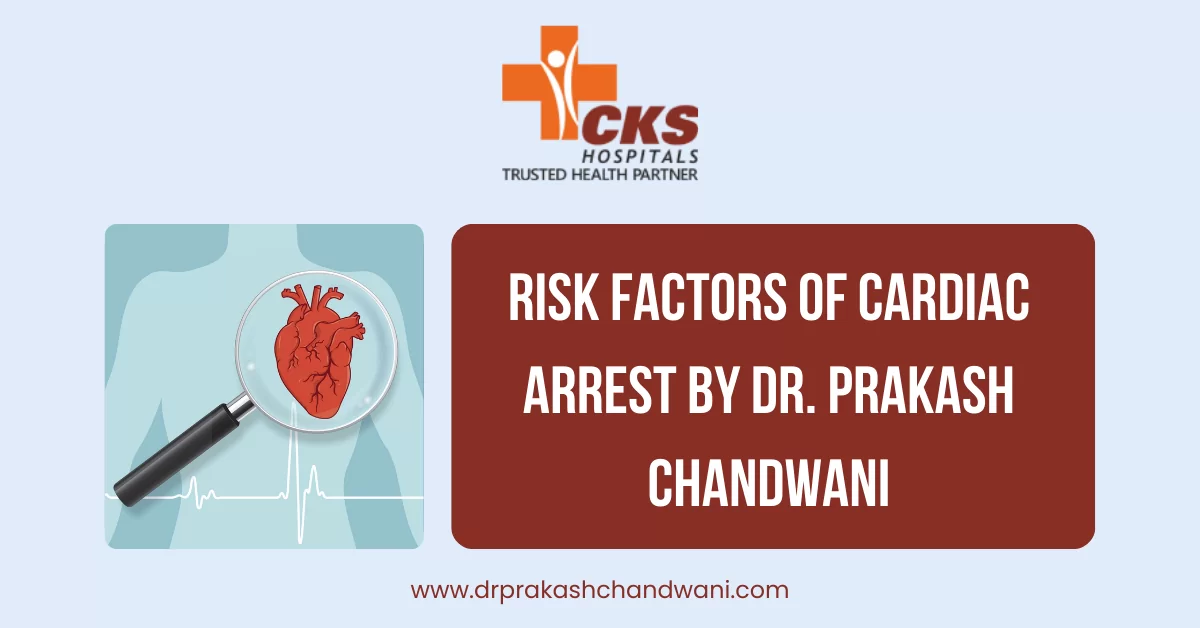

Understanding the Silent Threat: Risk Factors of Cardiac Arrest By Dr. Prakash Chandwani
Risk Factors of Cardiac Arrest By Dr. Prakash Chandwani: Cardiac arrest is a life-threatening condition that occurs when the heart suddenly stops beating, leading to an abrupt loss of blood flow to vital organs. Despite advancements in medical science, cardiac arrest remains a significant public health concern worldwide. While certain factors contributing to this condition are beyond our control, understanding and managing the modifiable risk factors can play a crucial role in preventing cardiac arrest.
In this blog, we will delve into some of the Risk Factors of Cardiac Arrest by Dr. Prakash Chandwani (Best Interventional Cardiologist in Jaipur).
Risk Factors of Cardiac Arrest By Dr. Prakash Chandwani
1. Uncontrolled Blood Sugars
One of the major risk factors for cardiac arrest is uncontrolled blood sugar levels, especially in individuals with diabetes. High blood sugar levels over time can damage blood vessels and nerves, increasing the risk of coronary artery disease. The narrowing of the arteries supplying blood to the heart can lead to a heart attack, which is a precursor to cardiac arrest.
Managing diabetes through lifestyle modifications, medication, and regular monitoring of blood sugar levels is essential in reducing the risk of cardiac arrest.
2. High Blood Pressure (Hypertension)
Hypertension, or high blood pressure, is a silent killer that significantly increases the risk of cardiac arrest. Elevated blood pressure puts extra strain on the heart, leading to the thickening of the heart muscle and an increased likelihood of heart failure. Additionally, high blood pressure contributes to the development of atherosclerosis, a condition characterized by the buildup of fatty deposits in the arteries.
Regular monitoring of blood pressure, adopting a heart-healthy diet, engaging in regular exercise, and, if necessary, taking prescribed medications can help manage hypertension and reduce the risk of cardiac arrest.
View this post on Instagram
3. Smoking
Smoking is a well-established risk factor for cardiovascular diseases, including cardiac arrest. The harmful chemicals in tobacco smoke damage blood vessels, promote the formation of blood clots, and increase the heart rate, all of which contribute to an elevated risk of cardiac events.
Quitting smoking is one of the most effective ways to reduce the risk of cardiac arrest. Support groups, counseling, and nicotine replacement therapy can aid individuals in their journey to quit smoking.
4. High Cholesterol Levels
Elevated levels of cholesterol, particularly low-density lipoprotein (LDL) cholesterol, contribute to the formation of atherosclerotic plaques in the arteries. These plaques can rupture, leading to the formation of blood clots that may block blood flow to the heart, triggering a heart attack and potentially culminating in cardiac arrest.
Adopting a heart-healthy diet low in saturated and trans fats, regular exercise, and medications prescribed by healthcare professionals can help manage cholesterol levels and reduce the risk of cardiac arrest.
5. Sedentary Lifestyle
A sedentary lifestyle, characterized by a lack of physical activity, is associated with numerous health risks, including an increased likelihood of cardiac arrest. Regular exercise not only helps maintain a healthy weight but also strengthens the heart, improves blood circulation, and lowers blood pressure.
Incorporating moderate-intensity aerobic exercise into daily routines, such as brisk walking or cycling, can contribute significantly to cardiovascular health and reduce the risk of cardiac arrest.
6. Family History
A family history of cardiovascular diseases, including cardiac arrest, can elevate an individual’s risk. Genetic factors may influence the predisposition to conditions such as hypertension, diabetes, and hypercholesterolemia.
While family history cannot be altered, individuals with a familial predisposition to cardiac issues should be particularly vigilant about adopting a heart-healthy lifestyle and undergoing regular check-ups to monitor and manage other risk factors.
Conclusion – Risk Factors of Cardiac Arrest By Dr. Prakash Chandwani
Understanding the risk factors associated with cardiac arrest is the first step toward prevention. By addressing modifiable factors through lifestyle changes, regular health check-ups, and adherence to medical advice, individuals can significantly reduce their risk of experiencing cardiac arrest. It’s crucial to prioritize heart health and make informed choices to safeguard against this silent but potentially deadly threat.

